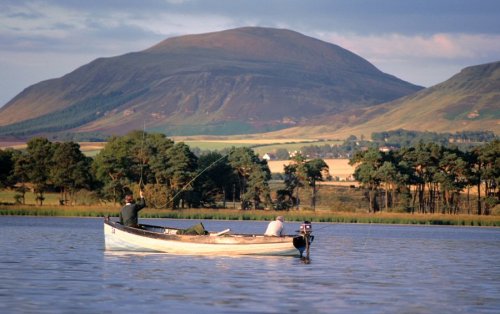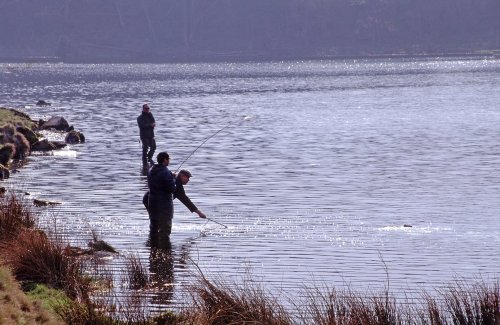Traditional Scottish 'loch-style' fly-fishing, from free-drifting boats, has changed and continues to change with each passing season...
Traditional Scottish 'loch-style' fly-fishing, from free-drifting boats, has changed and continues to change with each passing season. This is not solely a Scottish phenomenon; new ideas and practices are also evolving in Ireland where there are similar conditions and fly-fishing tactics. Some of the reasons for the trend are clear, others a little more complex, but the overall effect is that the classical conventions of trout fly-fishing in lochs are rapidly changing. Some rue this loss of part of our rich fishing heritage; whereas most are cheerfully optimistic about what is happening and accept that it is probably inevitable. Loch-style refers to the long-established traditional way of fishing for brown trout, in front of a free-drifting boat, (ie. downwind, with the breeze at your back). Loch-style fishing is mostly on, or near the surface, using a team of three or four small imitative or attractor fly patterns and the retrieval speed is quite slow. This does not involve casting huge distances, because, if you do, the boat overtakes the line before you are able to retrieve it. Most experienced anglers cast only a rod length or two in front of the boat.
The aim is to bring the trout onto the surface to elicit the taking response. Dibbling the bob-fly in the surface film attracts the fish although they may take one of the flies lower down the cast. This IS an absorbing and pleasant way of fishing, practised throughout the country, and is at its best in the wild lochs of the far north and west where the trout are hungry and fed at the surface. So, what has changed? Probably the most important change is the introduction of rainbow trout. Rainbows are able to adjust and survive in a variety of environments unlike their cousins, the native brownie. They also feed differently. Rainbows feed at a greater depth than brownies; they search the bottom of the loch, feeding primarily on larval stage bloodworms. At other times, they drop to lower levels to find cooler, more comfortable conditions, where the oxygen content in the water is higher. The dissimiliar behavioural patterns of rainbow trout have prompted anglers to modify their tactics; many anglers now fish imitation and attractor flies at greater depths. This is not to suggest that rainbows do not feed at the surface - they most certainly do - but, unlike brownies, they also feed at a wider range of depths and roam around to find suitable feeding locations.
Brown trout tend to favour shallower areas of stillwaters and mostly feed when insects emerge from the bed of the loch and rise to the surface to emerge as adult flies. This explains why the 'evening rise' occurs - that wonderful period of intense feeding activity when it seems that every fish in the loch is at the surface consuming hatching flies. Brown trout take the opportunity to feed intensively at the water surface when the hatching activity takes place. As a direct result of rainbow trout feeding at a wider range of depths, techniques have changed dramatically. The new approach to fly-fishing is known as 'reservoir-style' a style that incorporates the use of fast-sinking lines that place the fly close to fish lying at deeper levels. It has also resulted in the development of the fly-fishing 'lure' - where larger than life-sized flies are created, often in very lurid colours that are designed to tempt fish swimming in the murky depths. These lures frequently represent the fry of small fish, which rainbow trout take more voraciously than brown trout.
One of the other impacts to propel the change is the eutrophication of many lochs. This process of enrichment comes from many sources. As a consequence of inappropriate agricultural practices, fertilisers and other chemicals leach through the land and into the watercourses. Eutrophication may also result from in-river fish farming, where the effluent from uneaten food, treatment chemicals and faecal matter from closely-packed fish populations is released into the watercourse. In direct response to a shift in the chemical composition of the water, the habits of food chain species change. The feeding trout, therefore, must adapt their feeding behaviour accordingly. In the past, trout spent most of their time feeding on hatching flies at the surface, but now they feed at or near the bottom where food is more abundant.
Reservoir-style fishing relates to fishing at depth. Due to the high chemical content of England's lowland reservoirs and the fact that they are relatively shallow - there being few very deep valleys for impoundment in the mid-part of England - rainbows swim the entire area of the reservoir in search food. However, in the deeper Scottish waters, fish stocks tend to be concentrated in the shallower parts where food items are more abundant and accessible. Not too many English reservoirs stock with expensive-to-rear brownies - most introduce cheaper rainbows. These rainbows feed well and flourish 10 the warm, rich water. When introduced, they feed on a variety of food items, sometimes taking surface flies, but also accepting sub-surface insects, daphnia and juvenile coarse fish.
As a consequence, fly-fishing has changed from a top-of-the-water pastime to a sunk-line activity. Angler have, therefore, modified their tackle methods and tactics accordingly when reservoir fishing. No longer do we see free-drifting boats with anglers short-line fishing with small flies. Instead, anglers anchor where fish congregate, and fish with deep sunk lines and large lures or small static buzzer imitations. This must not be seen to be negative in any way, it is just different and it is highly effective.
Competitions have changed the ideology of traditional loch-style fishing too. Many competitions require the participants to fish at depth from free-drifting boats, but this requires the use of fast sinking lines that are able to get the flies down to the fish, then back, before the boat drifts over them. Long casting is the order of the day. The flies that are used today have changed too. Gone, for the most part, are the traditional feather-winged patterns, which are steadily being superseded by the marabou and tinsel attractors of modern rainbow fishing. These attractor patterns may not have to be large, in fact, they are limited in size for many competitions, but they may have to be brightly coloured to be visible at all in the gloomy depths of the reservoir.
Popular trout fly-fishing magazines have been instrumental in change to some degree too. Their readership is high in England, and many of the articles feature reservoir fishing for rainbows. This is entirely proper of course, but it clearly emphasises the role of the rainbow and the placing of reservoir fishing to those that read the magazines. Not very much is written about truly traditional brown trout methods, and there is an obvious bias towards reservoir fishing. What of the future? Will reservoir techniques completely take over from traditional styles? It is unlikely, especially in the more remote lochs where the trout are wild and the anglers wilder! Brown trout populations will continue to be natural and thrive where conditions favour. Rainbows are a great boon to stillwater fishing, but they need not be applied to every water. There is scope for each species, and the great variety of fishing styles that they each encompass.














